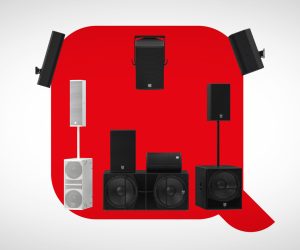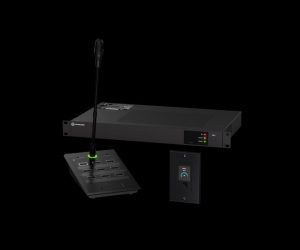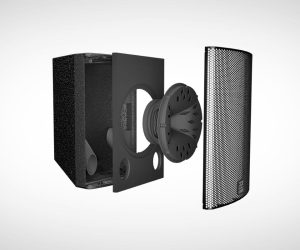
D&B XC-Series Stands for Clarity at St. Eugene’s Cathedral
St. Eugene’s Cathedral, the mother church of the Roman Catholic Diocese of Derry, opened in 1873 – and throughout the years since, generations of congregations have struggled with the acoustics inside the soaring stone interior. Now, however, following an extensive architectural refurbishment and technical systems upgrade, congregations can hear the services loud and clear and with greater consistency than ever before.
St. Eugene’s previous sound reinforcement system had never performed satisfactorily, as it was difficult to tame the reflections and reverberations in the space. Looking for a better solution, the church’s management turned to acoustical consultant Michael Kielty of Belfast-based MK Audio. Kielty recommended a distributed system, and contacted Absolute Technologies for a specific solution recommendation that would meet the church’s requirements.
Absolute Technologies, with their experience of similar reverberant spaces, from Christchurch Cathedral in Dublin to numerous smaller churches, had an immediate understanding of the challenges. Through their experiences, they became familiar with the exceptional pattern control and cardioid performance offered by the xC-Series column loudspeakers from d&b audiotechnik.
McKeown, supported by Oran Burns from d&b’s Application Support team, made an initial design for the church using d&b ArrayCalc software to predict coverage and decide on suitable loudspeaker positions. Following this, an in-situ system demonstration was arranged, which confirmed the ArrayCalc predictions and delivered the significant improvement the client was looking for.
The design uses an inner pair of d&b 24C-E cabinets at the front and an outer pair of 24C serving the aisles; further down the room are two more pairs of 24Cs as delays, again arranged as inner and outer pairs. The system is powered by two d&b D10 amplifiers.
Absolute Technologies’ installation manager, Colin McKendry explains, “In a big, highly reverberant room like this, one of the challenges is to stop reflection off the high ceiling, which can be heard as an annoying echo from above. The standard d&b 24C cabinet has six 4” LF drivers and an HF line array, giving us pattern control down below 400Hz. The ‘E’ is an extension to the LF drivers, which sits at the top of the 24C, giving another octave of pattern control, which helps to combat that problem.”
The other significant feature of the xC-Series columns that they’re cardioid in the horizontal. McKendry explains, “While a lot of column loudspeakers lose pattern control at around 2.5kHz, forcing the engineer to EQ out much of the lower frequency information to achieve intelligibility, the cardioid characteristic of the xC-Series extends that horizontal pattern control all the way down to the low frequencies.”
McKeown says, “The system’s main use is for speech, but also occasionally acoustic music. The d&b system handles it all perfectly: the tonal quality is excellent and the dispersion is very well controlled.”
For control, simplicity was key, with as little user interaction required as possible. An Allen & Heath Qu-Pac mixer is provided, with presets for the various regular services. “Most of the time it’s an automix of the main fixed microphone positions,” says McKeown. “And there is always the capability for full mix control (using the R1 remote control) on an iPad.”
Aside from intelligibility, St. Eugene’s presented another major challenge: building restrictions forbid the fixing of hardware to walls and pillars. The only option was the creation of custom floor-mount brackets. “Again, the appearance was very important,” McKeown emphasised. “The mounting had to look right in its environment and with the speakers. The brackets couldn’t enclose the rear of the speaker so as not to interfere with the cardioid pattern control, and as there could be no adjustment once it was mounted, the angle of pan for each speaker had to be built into the design of the bracket. Again, ArrayCalc was very useful in achieving this.”
Designed in conjunction with the architect and a specialist engineering company, each bracket is unique, to account for floor height and pan angle, and incorporates a plate for mounting beneath the floorboards and a rear cover to hide mounting bolts and cable. The back plate is finished in the same RAL colour as the loudspeaker, and the base plate in stainless steel to reflect its surroundings. “The mounts look like they are part of the speaker – it is a very elegant solution,” says McKeown.
“We all worked together to identify clear parameters and goals for the system and to tailor the design before installation commenced,” McKeown said. “Having d&b’s support gives us access to skills we may not have in-house, plus a high level of knowledge and experience from all types of projects. We’ve worked with Oran on a number of projects, and his knowledge of electroacoustics is invaluable. It gives the customer a great deal of confidence knowing we have the support of the manufacturer behind us.”
With the installation complete and the intelligibility and aesthetics boxes ticked, that confidence has been validated. “The clients have been delighted with the system,” McKeown confirms. “Right from the very first use, parishioners commented on how clearly they could hear, even at the back of the church, which was always an issue before.”
d&b audiotechnik: www.dbaudio.com
Australian Distributor: nas.solutions















RESPONSES